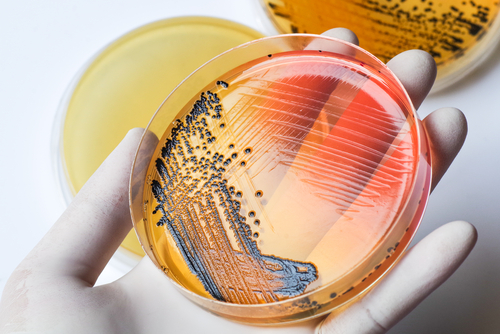Anti-Infective Agents Prevent Biofilm Formation of Yeast-Like Fungus in CF Patients
Written by |

Anti-infective agents such as Mycamine and Coly-mycin M can help prevent formation of Exophiala dermatitidis associated-biofilm structures, commonly found in cystic fibrosis (CF) patients, a new study found.
The study, “Biofilm formation of the black yeast-like fungus Exophiala dermatitidis and its susceptibility to antiinfective agents,” appeared in the journal Scientific Reports.
Between 1 and 19 percent of CF patients are infected with the black yeast-like fungi E. dermatitidis, which is active in extremely warm and humid environments like saunas, steam baths, and dishwashers.
E. dermatitidis can change its form from single-yeast state to an adherent-colony state called biofilm by adapting to the surrounding environment. This protects the fungus from the host’s defense system, making it resistant to antifungal agents and resulting in recurrent infections in a person.
Because CF patients are a risk group for serious and recurrent lung infections, physicians must understand how to manage infections caused by different microorganisms and prevent their recurrence.
The study’s authors analyzed 58 strains of E. dermatitidis of various origins: eight isolated from the environment, 15 invasive strains isolated from non-CF Asian patients, and 35 strains from the sputum of CF patients. They evaluated the strains for their ability to form biofilms and their response to several anti-infective compounds, specifically Vfend (voriconazole), Mycamine (micafungin), Coly-mycin M (colistin), farnesol, and two plant derivative compounds: pentagalloyl glucose (PGG) and epigallocatechin gallate (EGCG).
The antifungal compound Mycamine was the best antibiofilm agent, reducing biofilm formation by about 90 percent. Coly-mycin M, which affects the protective membranes of yeasts, came in second, cutting biofilm formation by 62 percent. Yet combinations of Mycamine and Coly-mycin M did not improve their efficacy against E. dermatitidis biofilms, researchers found.
The anti-biofilm effects observed were more promising when tested before cell adhesion than during biofilm formation process.
“Treatment of E. dermatitidis biofilm is most effective when carried out preventive[ly] and when administered to pre-formed biofilms,” the authors wrote.
Vfend reduced growth of E. dermatitidis biofilm during adhesion process, as well as that of mature biofilm. This activity was found to be strain-specific, with stronger effects against strains collected from CF patients than against non-CF invasive strains.
Farnesol inhibited adhesion of E. dermatitidis yeast by 25 percent, but it did not show any anti-biofilm activity against the mature biofilm structure. In contrast to the other anti-infective agents, the natural substances PGG and EGCG had no effect on biofilm formation at any step in the process.
These results suggested that use of these agents as prevention — especially Mycamine and Coly-mycin M — could be a more effective approach against biofilm-associated E. dermatitidis infections than their use as a treatment, the authors concluded.






